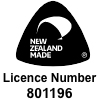Enamel / Oil based / High gloss Paints
Paints that have aged in the absence of ultraviolet light develop an extremely hard, impermeable surface that is difficult to adhere to. In exterior situations, this occurs in sheltered situations, such as the underside of weatherboards and under eaves and soffits. In interior situations, this condition is almost always prevalent, and the surface may be even more difficult to adhere to due to surface contaminants, such as soap contamination in bathrooms or grease contamination in kitchens. In all cases, glossy surfaces must be de-glossed by thorough sanding/keying. However, in special circumstances, some old two-component finishes may be so intractable as to require light abrasive blasting.
Acrylic paints
Acrylic paints continue to test for adhesion.
Test for adhesion
Clean an area of suspect coating and apply a strip of adhesive tape; ensure firm contact by rubbing with a fingernail. Rapidly pull off the tape at 90° to the surface. Examine the tape for any detached paint. Feather all edges of poorly adhering areas and immediately treat with a slurry coat to prevent ’edge curl’ with subsequent weathering.
Scrape and sand flaking paint.
Thoroughly scrape and sand areas with loose and flaking paint to provide a stable substrate for subsequent coats. Ensure all areas of flaked paint are thoroughly sanded to a feathered edge. Remove all sanding dust. If you wish to remove all existing paint, apply Resene Strip-Off as per directions to remove all paint. Thoroughly rinse clean with fresh water. Allow to dry.
Key surfaces
If the surface is particularly smooth, you must provide a mechanical key for subsequent coats. This can be done by running a grinder across the surface, leaving horizontal cuts to ensure the plaster can key into this. Ensure no dust is left on the surface.
Clean Surface
When the substrate has been left for a period of time, dust and dirt may build up on the surface. This contamination must be removed prior to render application.
Remove all moss and mould.
Thoroughly clean down to remove all loosely adhered material. Treat areas of moss or mould infestation with Resene Moss & Mould Killer correctly diluted with clean water. Leave for up to 48 hours to achieve a full kill; for heavy infestations, further applications may be needed. Wash thoroughly with clean water to remove residues. For difficult areas, carefully waterblast at 3000 psi to remove all dirt, chalk, moss, mould residue and any other contaminants. Allow the surface to dry out for at least 24 hours.
Remove powdery layers and efflorescence.
Remove any powdery layers, laitance or efflorescence by vigorous wire brushing or preferably water blasting. Thoroughly degrease by scrubbing or brushing down with Resene Roof Wash and Paint Cleaner to remove all dirt, dust, grease, chalk, cobwebs and other contaminants. Rinse clean with copious amounts of clean water, and the test surface is degreased by wiping with clean cotton wool. Repeat the process if necessary.
Waterblast
Resene Construction Systems recommends preparing the surface using a wash service, which involves applying special-purpose detergents and rinsing off with a relatively low water pressure using fan spray nozzles to prevent damage to the cladding. This will ensure a clean surface before applying a slurry coat.
Improve adhesion
A slurry coat must be applied to improve the adhesion of the RCS system.
Masking
Before applying the render, masking must be applied to all joinery, pipes, roofs, and all areas likely to be marked by the render. Use drop cloths and ground covers to keep the working areas clean.
Colour selection
For more information about light reflectance values refer to the technical note on the Resene Construction webpage at the following link https://reseneconstruction.co.nz/light-reflectance-values/






